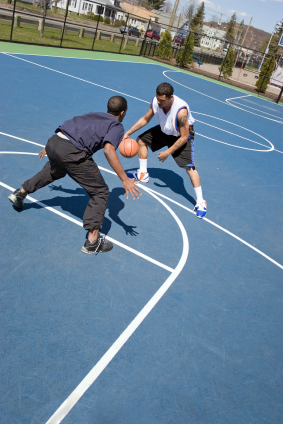One Thing Great Coaches Like Coach K Do
It was 1979 and I was sitting on a slab of concrete in the 90 degree heat at a summer basketball camp. I was about to be in 8th grade and loved basketball.
I wanted to show the coach of the local college that I was willing to do anything to get better. The coach was on the court demonstrating how we were supposed to play good man-to-man help defense. He was sweating like I was, and I loved it.
Though he was young and in his first head coaching job, I thought he one of the greatest coaches alive. His name was Coach Mike Krzyzewski, and he wasn’t just modeling good defense. He was modeling good coaching.
Looking back I did not realize I was a 13 year old prophet! Coach K is probably the greatest coach alive. (You get called by an initial when you have won 5 NCAA Championships…as of this week, and 2 Olympic Gold Medals.)
In 1979, he was coaching the Army basketball team. A year later he went to Duke where he has made and continues to make coaching history.
Model Coaching
What Coach K did that day and continues to do now is model what good looks like. He did not just tell us how to do something and walk away. He got out there and did it himself. He made sure we knew he was willing and able to do what he expected us to do.
Most great coaches model the behaviors they expect. I watched Nick Saban on 60 Minutes last week. He runs the most dominant college football program of the last decade. What I saw was a multi-million dollar head coach running up and down the field demonstrating the footwork he expected from his defensive backs.
I have seen the same type of modeling happen with the football, volleyball and basketball coaches who currently coach my twins in high school athletics. Great coaches don’t just tell people how to do something. Great coaches model what good looks like.
The way they coach should be a model to all of us who coach in business.
To read another blog on coaching click this title: A Mentor Attitude
Modeling in Business Coaching
Through the years, I have noticed many leaders in the business world are sub par coaches. There are many reasons for this. But, modeling is glaringly absent from many business leaders’ repertoire.
Many leaders are very good at explaining how something should be done. The good ones will spend as much time as is necessary with a team member in order to be sure they understand what needs to be accomplished.
Unfortunately, that is where many coaches in the business world stop. They walk away and hope the person gets it. If they don’t get it, the coach gets frustrated.
I’ve done that. At times, I got pretty exasperated when the individual kept returning for more clarification or asking me to clean up a mistake.
I guess I forgot what my favorite coaches did for me when I was growing up. They modeled! By seeing what good looked like I was better able to take their words and put them into action.
What can leaders model when coaching in a business situation?
Sales
- Cold calling on the telephone or in outside sales.
- Getting through gate keepers
- Handling customer objections.
- Negotiating new pricing structures.
Operations
- Scheduling line employees or machine scheduling.
- Conducting inventories.
- Part replacement or repair.
- Project Management.
Administration
- Answering the phones.
- Creating spreadsheets.
- Completing payroll.
- Contacting vendors.
Management
- Delivering performance reviews.
- Running weekly meetings.
- Preparing for weekly meetings.
- Preparing presentations for upper management.
Explaining how to do any of the above examples is critical and can be time consuming. Add modeling to the agenda and you can add more time to the process.
However, a leader actually saves time in the long run when she takes the time to model what good looks like early on. By modeling we appeal to both the ears and the eyes to speed understanding. Many people are visual learners versus auditory learners. Seeing it modeled will help them grasp the task more quickly.
Besides, if time is my biggest concern at this moment, I need to reconsider my priorities. My priority should be that team member’s success. The best coaches put the needs of the individual above their own convenience or desires.
If I spend more time up front modeling like great coaches do, I will spend less time answering clarifying questions and cleaning up mistakes later.
The Bottom Line:
For the great coaches like Coach K and Coach Saban, modeling is essential to coaching. These coaches know that they can get the most out of their players and help them become the best they can be, by modeling what good looks like.
In 8th grade, I knew that most successful basketball players were tall, fast and had a pretty good jump shot. What I did not realize then was I lacked all of those important characteristics.
None of that mattered that day in August of 1979. I had a coach who inspired me by showing me what good looked like. I never did develop a great shot or get much faster. But, I did become the best defensive player I could be.
Isn’t that what we should all desire for those we coach? Shouldn’t we work to make them the best version of themselves they can be?
Whether we are coaching at work or on a basketball court, we all should want those we coach to get better. To make that happen, the great coaches model.
Question:
What activity can you model for someone you lead, mentor or parent?


Your story reminded me of a time when I realized that my younger brother looked to me as a role model. During adolescence, I looked for a way to level the playing field with my peers. I was not very tall and I was not very fast. I was a chubby sixth grader looking to move up from being last pick for baseball games. I remember thinking to myself, “I can’t run fast, so I’ll run far.” God smiled at me as he planted the determination in my heart to become a long distance runner.
Little did I know, my younger brother was watching me exercise each morning. Every morning, come rain or shine, I got up earlier, put on my sneakers, and ran several miles. In the end, I won several races, as well as the respect of my peers. I went on to run the mile and two mile races in high school.
One Saturday morning, when I was about sixteen years of age, my little brother asked me to go with him to school and time him with my stopwatch as he ran around the quarter mile track—he was seven years old. It was then that I learned the importance of being a good role model. Showing is quite often more powerful than just telling.
Great story Martin! I love it!
David,
A great lesson you passed on to all of us.
Thank you!!!
DAD
I was at West Point in 1979; while I didn’t play for Coack K, I knew by reputation, through other members of the Corps, what kind of leader he is.
Coach K learned something early in his career that all military leaders learn: you don’t ask your soldiers to do anything you aren’t willing to do yourself. That applies, I believe, anywhere there are leaders and followers: whether it’s in a motor pool working until midnight to prepare for an inspection, in field training with guardposts out to defend against an imaginary enemy, or (I would suspect) kicking down doors to root out insurgents, “Follow Me!” resonates much better than “Hey, go get that done and let me know when you’re through”.
Some of my most unpleasant manager memories revolve around being placed in near-impossible situations at work, required to “just go sell it”, when I had no idea how to bypass the obstacles before me. What was even worse was realizing my manager had no idea, either!
By the same token, some of my most inspiring leaders, in both the military and in Corporate America, have been willing *and able* to demonstrate what they expected of me. With them it wasn’t a theoretical; they hunkered down and *showed* me.
Now that I manage people, I want nothing more than to be competent to show my team what “good” looks like, and to set the standard myself that I expect of them. I owe it to them to be the best that *I* can be, in order to help them be the best *they* can be.